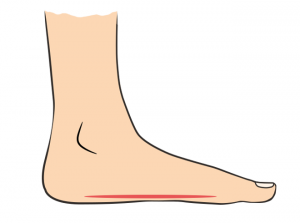Pain in the Feet
Your doctor may offer non-surgical treatment if you have foot pain, stiffness, or other issues. Advanced foot and ankle podiatrists may consider more conservative treatment options for flat feet, however there are numerous surgical possibilities.
Consult an orthopaedic surgeon, podiatrist, or your regular doctor if you experience foot pain or difficulty walking or running. Consult your foot and ankle specialist for an assessment if your feet are causing you troubles. The specialist evaluates how your feet move and change shape while sitting, standing, and walking, as well as the structure of your feet.
Flat feet impair many elements of a person’s general health, according to many people with flat feet. There is no reason to be concerned if there is no severe discomfort in other feet, ankles, or legs, or if your flat feet are not causing any anomalies. A lack of arches, severe pain, and exhaustion on the inside of the foot and under the arch are the most common symptoms of flat feet.

When walking, flat feet can lead to overpronation or ankle roll. People with flat feet are also prone to a condition known as plantar fasciitis. You’re more likely to develop foot pain if your feet don’t get the support they need from flat feet.
Children’s flat feet Pin it to Pinterest When the arch is fully grown, a youngster seems to have a flat foot. When standing, flat feet occur when the arches are excessively deep. They can also happen as a result of developmental abnormalities that start in childhood and can develop at any age, including during pregnancy.
The weight of being flat is carried by the foot, and it has little to no arch, causing the entire sole of the foot to come into touch with the ground.
When the foot has a regular arch, flat feet cannot keep the body stable. A flat foot, sometimes known as a flat foot sound, is a foot with a flat bottom or plantar surface, no bow, and a lowered instep. Flat feet is a disorder that affects people who have no or very little arch in their feet.
If you stand next to someone who doesn’t have flat feet, you’ll see a gap between the inner part of their foot and the floor where a regular arch would protrude.
When you lift your foot off the ground or when your soles hit the ground when you put your foot down, the arch of your foot shows. It appears that you’re lifting your foot up if you can’t see the arch of your foot. The bow can also be seen standing, and if it is older than a child, it can be seen standing on tiptoes with the child.
Inflammatory arthritis does not cause pain, but it can modify the contour of the foot and cause it to flatten. A tear of the leg tendons, particularly the posterior shin tendon that supports the arch of the foot, is the most prevalent cause of inflammation. As a result of a flipped arch, it can also impact the back of the foot or the center of the foot.
Poor foot alignment and strength can cause injury by affecting how you hold your body. An injury to the ligaments that support the foot can cause the joints to become misaligned.
Many patients are unaware that their feet are the source of their discomfort, even if they have previously experienced knee, hip, or neck trouble. Flat feet or a collapsing arch are frequently misdiagnosed as arthritis or plantar fasciitis, which are not treatable and can even self-treat if left untreated. The rest of our body redistribute our weight when the arches of our feet change.
The ankles, knees, hips, lower legs, and lower back are the most prevalent regions of pain for those with flat feet. Flat feet can also be caused by simple ailments such as wear and tear, tension, or old age.
Because flat feet disrupt the position of the legs, they can create difficulties with the ankles and knees. Foot pain in the heel and arc area affects some people with flat feet. Flat feet can create problems, but there are simple devices and exercises that can help alleviate the pain.
Pin it to Pinterest A person with a flat foot has a lower, non-existent arch. The Tarsal coalition, in which the bones at the back of the foot fuse or interlock, can be diagnosed with a thorough physical examination and X-ray; this condition can also be seen on an MRI or CT scan. Because flat feet can be caused by poor bone growth or a disorder such as spina bifida in children, doctors must address the underlying reason.
The arch of the foot absorbs the physical impact of landing and creates the force necessary to repel and alter equilibrium during walking. The arch of the foot, which allows the center part of the foot to expand and close, provides spring force and flexibility to the foot.
As we move, the arches also assist in distributing the weight of the body to the feet. The bows work like feathers, distributing our body weight and allowing us to move freely. The ligaments in the arches (all three) can rupture or relax with age, causing them to fall off, causing foot pain in many people.
